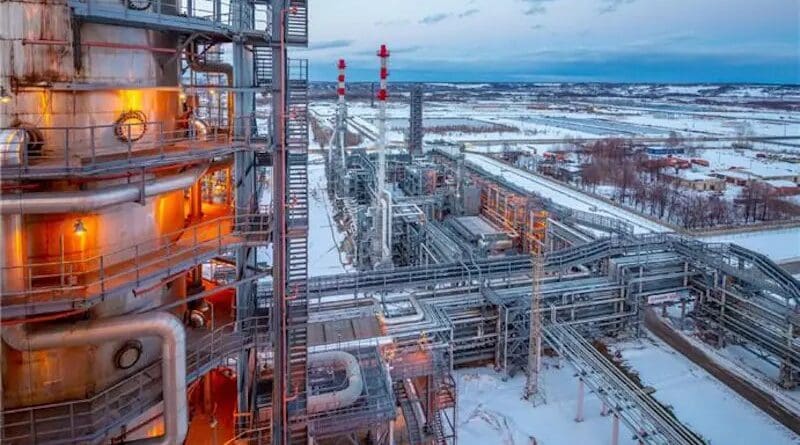The Feasibility Of Discounted Russian Fuel – OpEd
By Ujala Siddiq
The decision of the United States to penalise Russia for initiating conflict with Ukraine was to isolate Russia financially, diplomatically, and politically to unprecedented levels, in addition to providing massive amounts of military and financial aid to Ukraine. Iconic businesses operated by US-based corporations like Coca-Cola, Pepsi, McDonald’s, and Starbucks, among many others, suspended their businesses in Russia soon after the conflict began.
On March 2, 2022, the United States stood against Russia in the UNGA and imposed an oil embargo with new sanctions on Russia resulting in a sharp 50 percent decline in Russian oil exports. More than 60 percent of the fuel requirement of the US’s European allies was fulfilled by Russia and that reliance served as a financial and strategic shield for Putin. The Chief of the European Commission Ursula von der Leyen said, “I am very glad that the leaders were able to agree in principle on the sixth sanctions package.” Although there is consensus among European nations on the need and purpose of the sanctions, the impact of the aforementioned sanctions is hurting them at the same time. On March 8, 2022, during an interview with CNN, President Biden announced a ban on Russian energy imports saying that “Americans will not be part of subsidising Putin’s war”.
Several European countries were relying to a great extent on Russian oil and gas. The cumulative sanctions and the complete cut-off of Russian oil brought serious economic repercussions. Bloomberg reported that Hungarian Prime Minister Viktor Orban exclaimed, “A full embargo would turn out to be an ‘atomic bomb’ for the Hungarian economy.” Brookings talked about a similar strategy of sweeping economic sanctions used by the Trump administration against Iran to cut down the exports of oil and gas that resulted in stopping India from importing Iranian oil under the pressure of the US — but in the case of Russia, things are different.
Russia is trying to expand to new markets in Asia. The EU countries have decided upon a total ban on the import of Russian crude, whereas, India and China have stepped in to import record volumes of Russian crude, according to data from energy analytics provider Kpler. Indian imports from Russia increased three–fold after the Russia-Ukraine conflict escalated. According to the Hindustan times, “The surging energy imports helped push India’s total goods imports from Russia between February 24 and May 26 to US $6.4 billion, compared with US $1.99 billion in the same period last year.” India is the third largest importer of oil in the world and enjoys discounted crude oil trading at around US $49 per barrel, whereas the price cap rate is US $60 a barrel. The increase in imports, according to UBS analyst Giovanni Staunovo, was caused by recovering Indian demand and the use of discounted Russian crude for domestic and strategic storage before it was refined and exported as an oil product.
In terms of Pakistan availing access to cheaper prices, according to the Trade Development Authority of Pakistan, 56 percent of its oil and gas is imported from Saudi Arabia, while 34 percent is from the UAE — but none from Russia. On December 5, 2022, Minister of State for Petroleum Musaddiq Malik claimed in a news briefing that “Russia will also supply discounted petrol and diesel to Pakistan.” The price and logistics of this discounted fuel were not discussed. A recent talk between the Minister of Energy of the Russian Federation Nikolay Shulginov and Musaddiq Malik took place on 19th January, regarding enhancing cooperation between both countries happened. Such statements were also made by the previous government, the unfolding of the events will clarify the situation more, but there is required an analysis of the logistics, cost of refinement, supply chain issues and unprecedented sanctions reveals that discounted Russian fuel is a feasible option or not. Pakistan already enjoys friendly relations with oil-rich Gulf nations, and a more prudent approach would be to further avail that friendship to seek ease in the import burden. For long-term solutions, the government should consider alternative energy solutions. Vietnam was also suffering from an energy crunch and high energy import prices. In the space of just a year, Vietnam was able to increase its rooftop solar production capacity by a staggering 25-fold — producing more than nine gigawatts in 2020. Over 101,000 rooftops installed solar to address energy shortages. Pakistan can greatly benefit from such measures.
The current economic stress necessitates taking pragmatic and rational decisions. Oil worth US $17.03 billion was imported during the first 10 months (July-April) of the last fiscal year (10MFY22) to meet the country’s energy needs — an increase of almost 96 percent increase from the oil import bill compared to the same period of FY21. Relying to this extent on imported fuel or offering subsidies is not a sustainable policy. A concentrated effort needs to be made for reconfiguring the country’s energy mix with renewables.
Ujala Siddiq is a researcher at the Centre for Aerospace and Security Studies (CASS), Lahore, Pakistan. She can be reached at [email protected]

